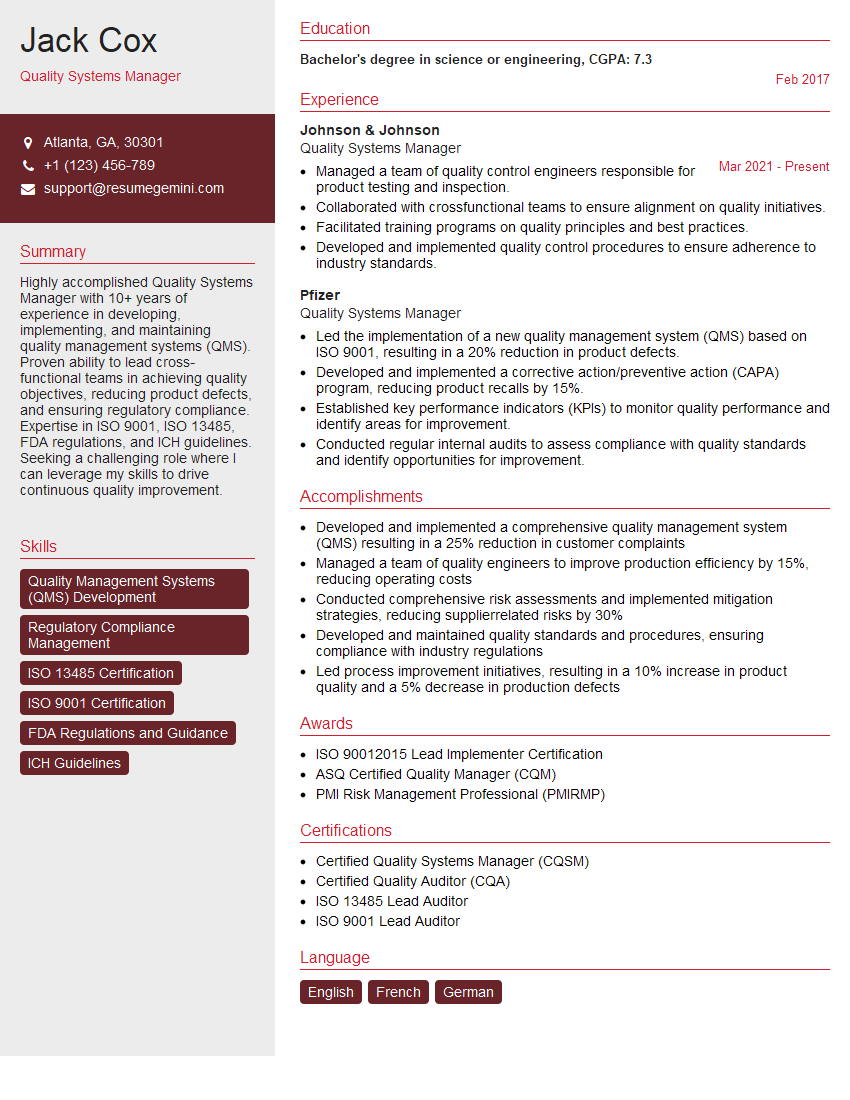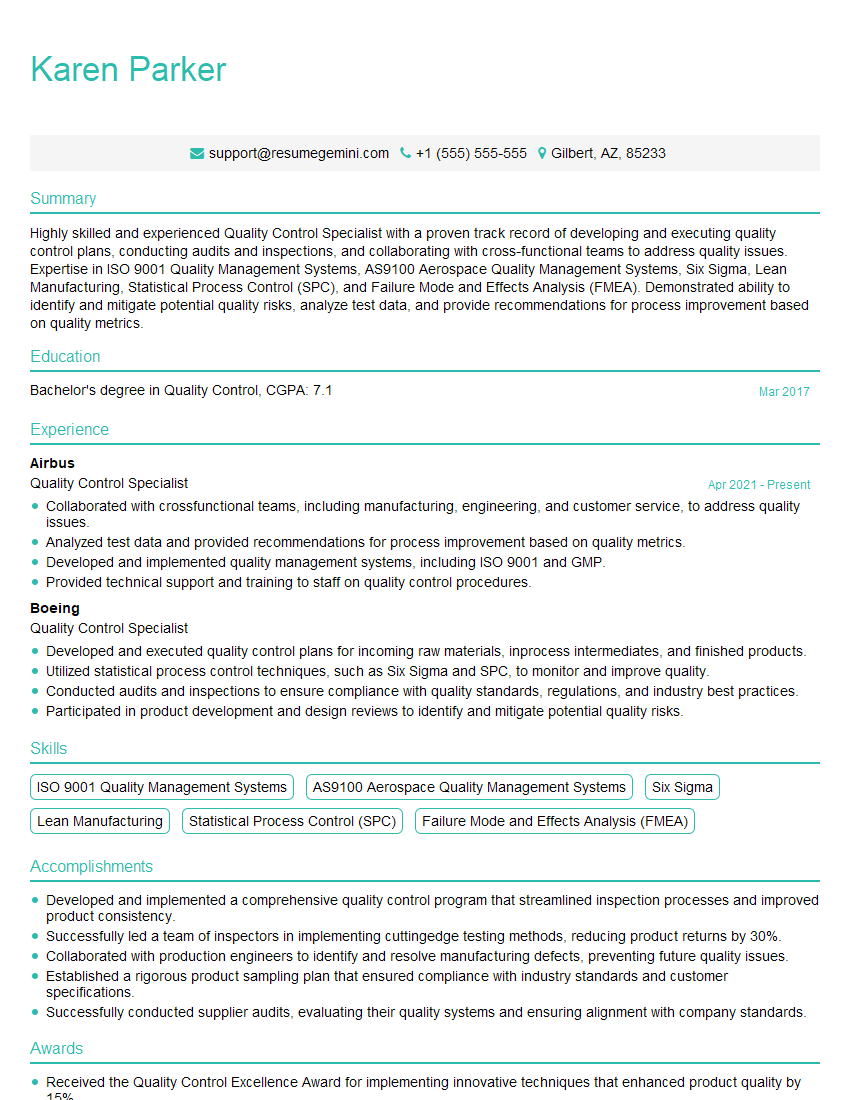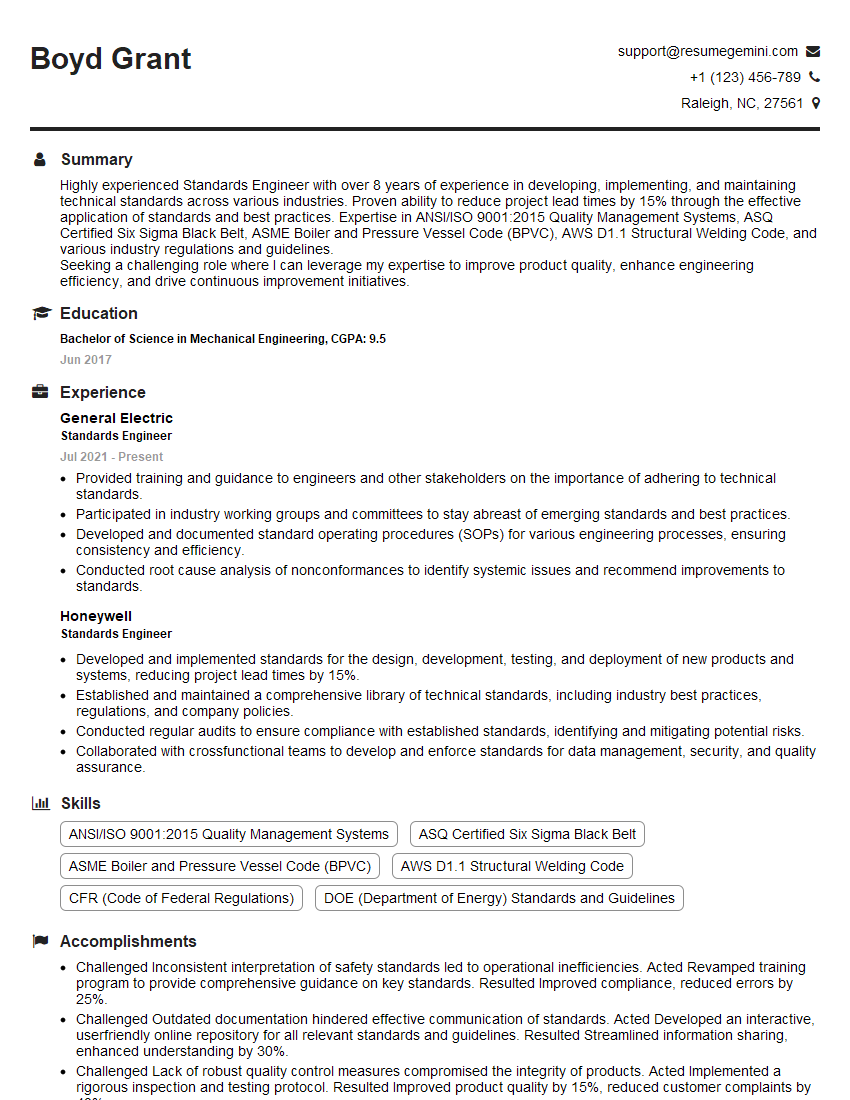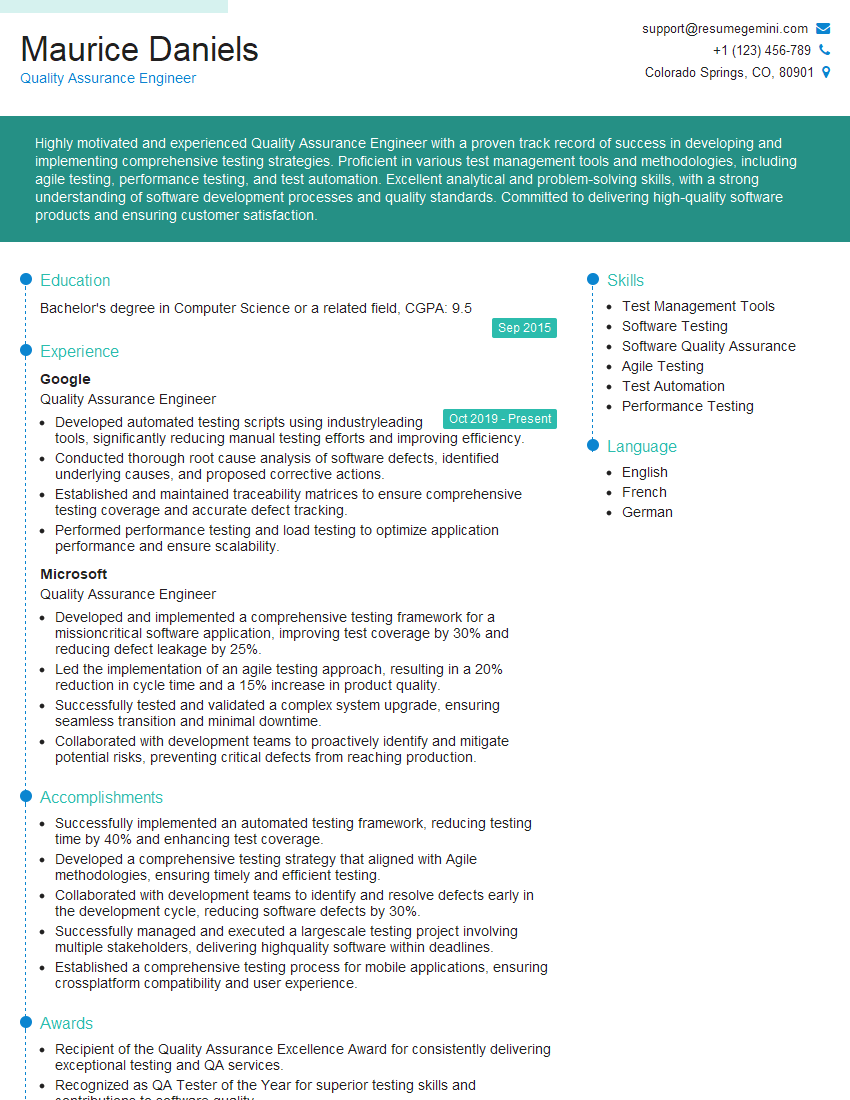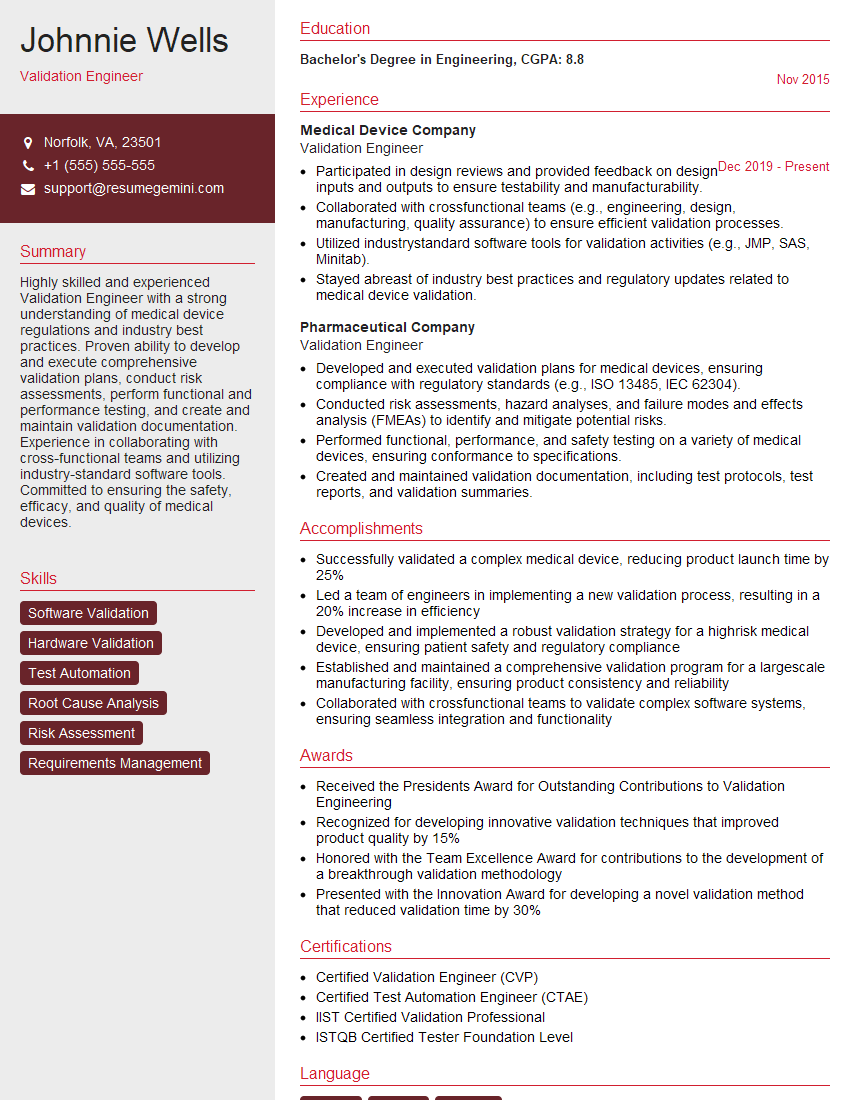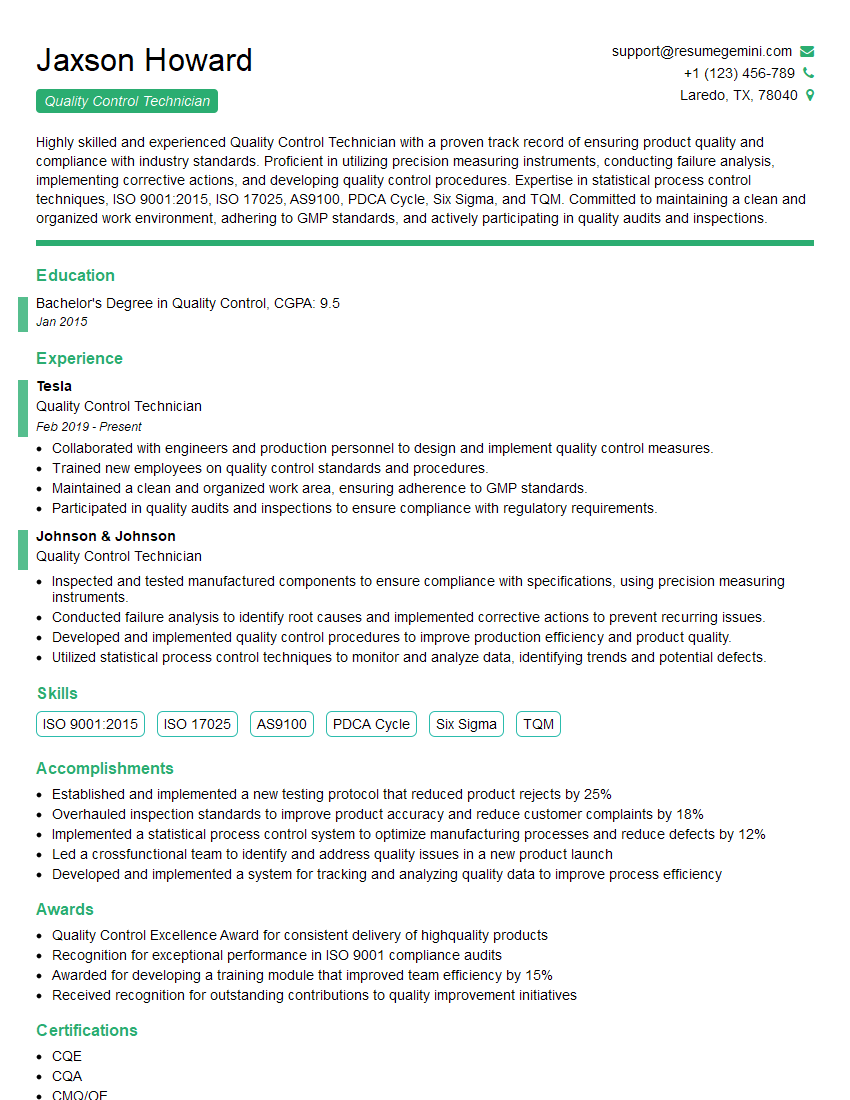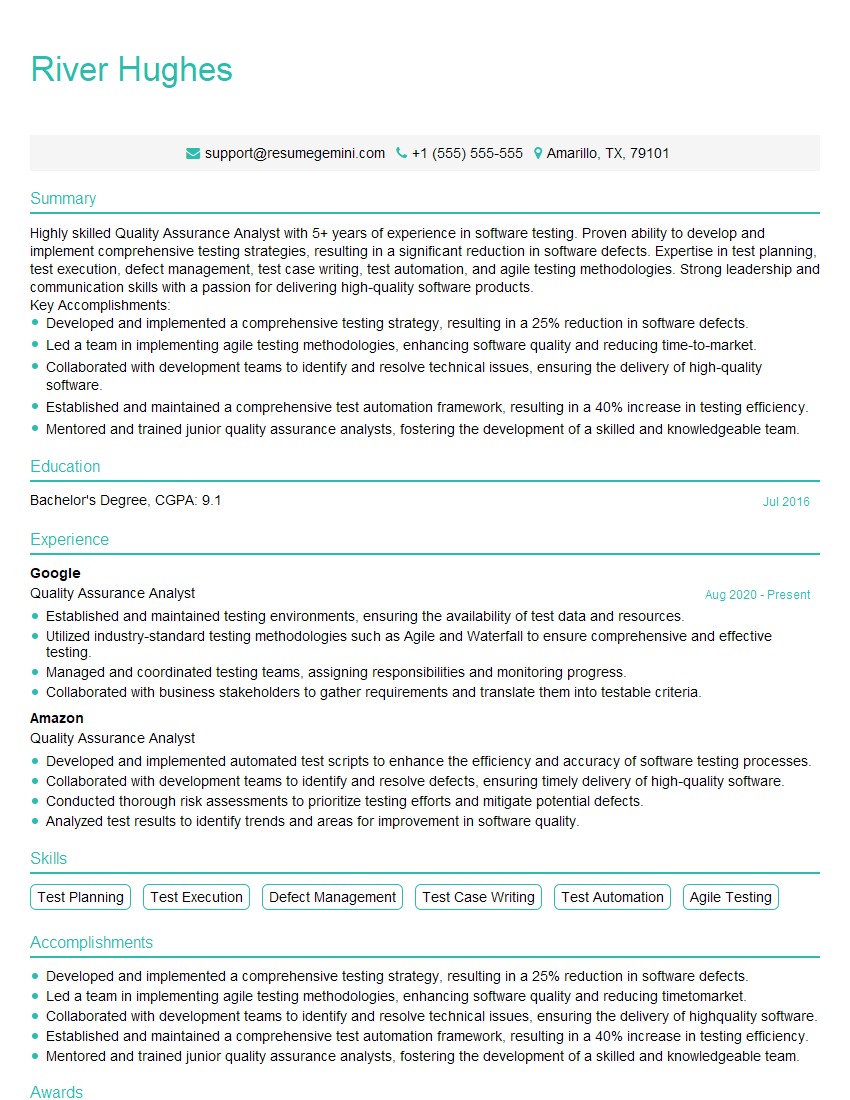Feeling uncertain about what to expect in your upcoming interview? We’ve got you covered! This blog highlights the most important Ensuring that all work meets or exceeds industry standards and customer specifications interview questions and provides actionable advice to help you stand out as the ideal candidate. Let’s pave the way for your success.
Questions Asked in Ensuring that all work meets or exceeds industry standards and customer specifications Interview
Q 1. Describe your experience ensuring products meet industry standards.
Ensuring products meet industry standards is paramount to delivering high-quality, reliable products and maintaining a positive brand reputation. My approach involves a multi-faceted strategy encompassing proactive planning, rigorous testing, and continuous improvement.
For instance, in my previous role at Acme Manufacturing, we adhered strictly to ISO 9001 guidelines. This involved implementing a robust Quality Management System (QMS) that covered every stage of the manufacturing process, from initial design and material sourcing to final testing and delivery. We regularly audited our processes, meticulously documented everything, and implemented corrective actions whenever deviations were found. This proactive approach helped us maintain consistent compliance and ultimately minimize potential risks and defects.
Another example involves working with industry-specific regulations. In the medical device industry, for example, compliance with FDA regulations is non-negotiable. We used rigorous validation and verification processes to ensure our products met all regulatory requirements, including extensive testing and documentation. Failure to comply would lead to costly recalls and reputational damage, hence the thoroughness of our approach.
Q 2. How do you identify potential quality issues during a project?
Identifying potential quality issues is a proactive, multi-pronged approach that begins even before a project starts. It’s not just about detecting problems after they occur; it’s about preventing them in the first place.
- Design Review: Thoroughly reviewing product designs, specifications, and manufacturing processes before production begins to catch potential flaws early on. This is like reviewing a blueprint before starting to build a house.
- Material Inspection: Carefully inspecting incoming raw materials to ensure they meet required quality standards. A faulty component at the beginning will create a faulty product at the end.
- Process Monitoring: Continuously monitoring production processes through regular checks and data analysis to identify deviations or inconsistencies. Think of this as regularly inspecting a construction site to ensure everything adheres to the blueprint.
- Testing and Inspection: Conducting rigorous testing at various stages of production to identify and correct defects. This is like quality assurance checks during and after the construction process of the house.
- Feedback Mechanisms: Actively soliciting feedback from customers and employees to identify areas for improvement. Customer feedback often surfaces hidden issues that internal checks may miss.
Q 3. Explain your approach to resolving discrepancies between customer specifications and manufacturing capabilities.
Discrepancies between customer specifications and manufacturing capabilities are a common challenge. My approach involves a collaborative problem-solving process, involving engineers, designers, and procurement teams. It is all about finding a balance between meeting customer needs and what is practically achievable and cost-effective.
- Open Communication: First, I initiate open communication with the customer to understand the importance of each specification and the flexibility they may have. Sometimes, seemingly minor adjustments can make a major difference.
- Feasibility Analysis: Next, I conduct a thorough feasibility analysis, assessing whether the requested specifications are achievable given our resources and current manufacturing capabilities. This often involves exploring alternative materials, processes, or designs.
- Value Engineering: If discrepancies exist, I apply Value Engineering principles to find cost-effective solutions. This involves exploring alternative designs or materials that achieve the same functionality but within our manufacturing capabilities.
- Negotiation and Compromise: Finally, I engage in constructive negotiation with the customer to find a mutually agreeable solution, potentially involving trade-offs or adjustments to specifications and timelines. It’s about finding a balance, not a win-lose situation.
For example, if a customer requests a material that’s too expensive or hard to source, we may explore suitable alternatives that still meet the core performance requirements. Transparency and collaboration are key to resolving these challenges effectively.
Q 4. How do you utilize quality metrics to track progress and identify areas for improvement?
Quality metrics are essential for tracking progress and pinpointing areas needing improvement. They provide objective data to measure performance against established goals and identify trends that might otherwise be missed.
I typically use a variety of metrics, including:
- Defect Rate: The percentage of defective products produced. A high defect rate indicates problems in the manufacturing process.
- Yield Rate: The percentage of products successfully produced without defects. A low yield rate points to inefficiencies.
- Cycle Time: The time taken to complete a production cycle. Tracking cycle time reveals bottlenecks and areas for improvement.
- Customer Satisfaction: Surveys and feedback metrics gauge customer satisfaction with the quality of the product.
- Cost of Quality (COQ): This metric incorporates prevention, appraisal, and failure costs, providing a holistic view of the cost of quality. It’s a useful metric for return-on-investment analysis for quality improvements.
By regularly monitoring these metrics, we can identify trends, proactively address problems, and measure the effectiveness of improvements made. The data should drive decisions and inform continuous improvement efforts.
Q 5. What quality control tools are you familiar with (e.g., Six Sigma, ISO 9001)?
I’m proficient in several quality control tools and methodologies. My experience includes the application of:
- Six Sigma: A data-driven methodology focused on reducing defects and improving process efficiency. I’ve utilized Six Sigma’s DMAIC (Define, Measure, Analyze, Improve, Control) methodology to solve numerous quality problems.
- ISO 9001: A globally recognized standard for Quality Management Systems. I’ve led teams in implementing and maintaining ISO 9001 compliance, ensuring adherence to quality standards throughout the organization.
- Statistical Process Control (SPC): I use SPC charts (like control charts) to monitor process variability and detect abnormalities, ensuring processes stay within acceptable limits.
- Failure Mode and Effects Analysis (FMEA): I use FMEA to identify potential failure points in a process or product and prioritize corrective actions. This proactive approach helps prevent defects before they happen.
- Root Cause Analysis (RCA): When quality issues arise, I utilize various RCA techniques (e.g., 5 Whys, Fishbone diagrams) to systematically identify and address the root causes, rather than merely treating symptoms.
Q 6. Describe a time you had to address a significant quality issue. What was your approach?
In a previous project involving the production of precision-engineered components, we encountered a significant quality issue – an unexpectedly high rate of component failures in the field. Initial investigations pointed towards a potential material defect.
My approach was systematic:
- Data Collection and Analysis: We began by meticulously collecting data on the failed components, including failure modes, location, and usage patterns. This involved analyzing returned products and field reports.
- Root Cause Analysis: We conducted a thorough root cause analysis, involving both internal teams and external experts. This uncovered a flaw in the heat-treating process used for a specific component, causing inconsistent material properties and leading to premature failure.
- Corrective Actions: We immediately implemented corrective actions, including revising the heat-treating process, rigorous retesting of materials, and 100% inspection of all affected components. This involved significant investment in new equipment and training.
- Preventive Measures: To prevent recurrence, we enhanced our quality control system, implementing more frequent inspections during the heat-treating process and strengthening our supplier relationships to ensure consistent material quality.
- Communication: Finally, we proactively communicated with affected customers, offering replacements and explaining the corrective actions taken. Transparency and open communication were critical in maintaining customer trust.
This experience highlighted the importance of a systematic approach, collaboration, and proactive communication in addressing significant quality issues. The key was not just fixing the immediate problem, but implementing changes to prevent similar failures in the future.
Q 7. How do you balance the need for quality with project deadlines and budget constraints?
Balancing quality with deadlines and budget constraints requires a strategic approach that prioritizes the most critical quality aspects and efficient resource allocation. It’s not about compromising quality; it’s about optimizing the process to achieve the best possible outcome within the given limitations.
My approach involves:
- Prioritization: Identifying the critical quality characteristics that are essential to product functionality and customer satisfaction. These aspects receive the highest priority, even with tight deadlines.
- Risk Assessment: Assessing potential risks associated with shortcuts or compromises. This helps focus efforts on the areas where the impact of potential failures would be highest.
- Process Optimization: Streamlining processes to improve efficiency and reduce waste without compromising quality. This might involve automation, improved workflows, or better resource allocation.
- Resource Allocation: Carefully allocating resources to the critical quality aspects. This ensures that the most important aspects of quality are adequately addressed, even with limited resources.
- Open Communication: Maintaining open communication with stakeholders (customers, project managers) to manage expectations and ensure everyone is aware of potential trade-offs. Transparent communication helps prevent conflicts and allows for informed decision-making.
It’s like building a house – you might need to make some choices on the finer details to meet a deadline and budget, but you wouldn’t compromise on the foundation or structural integrity. Quality is about building a solid foundation, and efficient management ensures you can complete the project within constraints without sacrificing the critical elements.
Q 8. How do you communicate quality issues and solutions to different stakeholders?
Communicating quality issues effectively requires a tailored approach depending on the stakeholder. For instance, a technical report outlining the defect’s root cause and proposed solution would be appropriate for engineering teams. However, a concise email highlighting the impact on the project timeline and the steps taken to mitigate the risk would be more suitable for upper management. I believe in transparency and proactively involve stakeholders in the problem-solving process. This fosters trust and facilitates collaboration.
Example: In a previous project, we identified a critical software bug. I prepared a detailed technical report explaining the defect, its impact, and the proposed fix for the development team. Simultaneously, I summarized the key findings and the mitigation plan in a concise email to project management and senior stakeholders, keeping them informed without overwhelming them with technical details.
- Technical Audience: Detailed reports, technical specifications, data analysis.
- Management Audience: Concise summaries, impact assessments, action plans.
- Clients: Clear, non-technical explanations, focusing on impact and solutions.
Q 9. What is your experience with implementing and maintaining quality management systems?
I have extensive experience implementing and maintaining ISO 9001-compliant Quality Management Systems (QMS). My experience spans the entire lifecycle, from initial gap analysis and documentation development to ongoing monitoring, review, and improvement. This includes defining clear quality objectives, establishing documented processes, implementing quality control procedures, and ensuring regular internal audits.
In a previous role, I led the implementation of a new QMS for a manufacturing facility, which resulted in a 20% reduction in defects and a 15% improvement in on-time delivery. This involved training all personnel on the new system, establishing key performance indicators (KPIs), and using a collaborative approach to ensure buy-in across all departments. The success was directly attributable to clear communication, thorough training, and a focus on continuous improvement.
Q 10. How do you ensure your team understands and adheres to quality standards?
Ensuring team understanding and adherence to quality standards is a continuous process. It starts with clear, concise training on relevant standards, company procedures, and best practices. Beyond initial training, I utilize various methods to foster a culture of quality. This includes regular team meetings, where we discuss quality issues, share best practices, and brainstorm solutions; using visual aids like checklists and flowcharts to simplify complex processes; and incorporating quality checks at various stages of the workflow.
Example: I’ve successfully used gamification to incentivize adherence to quality standards. A simple points system, rewarding teams for consistently meeting targets and adhering to procedures, dramatically improved performance and engagement. Regular feedback sessions and constructive criticism also play a key role.
Q 11. How do you handle situations where a customer’s specifications are unclear or conflicting?
Handling unclear or conflicting customer specifications requires proactive communication and clarification. My approach involves first seeking clarification through direct engagement with the client, ensuring a complete understanding of their requirements. This may include follow-up meetings, detailed questionnaires, or requests for additional information. If ambiguities persist, I propose alternative solutions, outlining the trade-offs of each approach and collaboratively deciding on the best path forward. It’s crucial to document all agreements and clarifications to prevent future misunderstandings.
Example: Once, a client’s specifications for a software module were vague regarding its integration with other systems. I scheduled a meeting with the client’s technical team to clarify requirements. We produced a revised specification document collaboratively, ensuring a shared understanding before proceeding.
Q 12. What is your experience with audits and regulatory compliance?
I have extensive experience with audits, both internal and external, and ensuring regulatory compliance. I’ve participated in ISO 9001, ISO 14001, and other industry-specific audits. My role often includes preparing for audits by ensuring all documentation is up-to-date and all processes are in compliance. I’ve also led corrective and preventative action (CAPA) initiatives to address any identified non-conformances. This experience extends to assisting with regulatory compliance, ensuring that all work meets the requirements of relevant laws and regulations.
Example: In a recent ISO 9001 audit, we identified a minor deficiency in our documentation control process. I led the CAPA process, which involved revising our procedures, implementing a new tracking system, and retraining relevant personnel. The corrective actions successfully addressed the deficiency and ensured compliance.
Q 13. How do you measure the effectiveness of your quality control processes?
Measuring the effectiveness of quality control processes relies on key performance indicators (KPIs). These can include defect rates, customer satisfaction scores, on-time delivery rates, and process cycle times. I regularly monitor these KPIs using data analysis tools and dashboards to track performance trends. Regular reviews of these metrics enable identifying areas for improvement and adjusting processes to enhance quality and efficiency.
Example: We track defect rates per project phase, customer satisfaction through surveys, and on-time delivery rates using a project management software. Analyzing these KPIs allowed us to pinpoint a bottleneck in the testing phase, leading to the implementation of improved testing procedures and a significant reduction in defects.
Q 14. Describe your experience with root cause analysis.
Root cause analysis (RCA) is a crucial aspect of continuous improvement. I’m proficient in various RCA methodologies, including the ‘5 Whys,’ fishbone diagrams (Ishikawa diagrams), and fault tree analysis. My approach always begins with gathering all relevant data and information. Then, I work systematically to identify the underlying causes of problems, moving beyond superficial symptoms to uncover the root issues. This ensures lasting solutions instead of merely addressing immediate symptoms.
Example: In one instance, a high number of customer complaints regarding a product’s functionality were initially attributed to user error. However, using the ‘5 Whys’ method, we progressively investigated the cause, revealing a flaw in the product’s design that led to inconsistent performance under specific conditions. This led to a redesign of the product component, permanently resolving the issue.
Q 15. How do you proactively prevent quality issues from arising?
Proactive quality management isn’t about fixing problems after they arise; it’s about preventing them in the first place. This involves a multi-pronged approach focusing on process control, employee training, and continuous improvement.
- Robust Process Design: We begin by meticulously designing and documenting every process step. This includes clear instructions, checklists, and defined acceptance criteria. Think of it like building a house – a solid blueprint minimizes errors during construction.
- Preventive Maintenance: Regular maintenance on equipment and machinery is crucial. Scheduling preventative maintenance prevents unexpected breakdowns that could impact quality and deadlines. Imagine a car – regular oil changes and tune-ups prevent major issues down the line.
- Employee Empowerment and Training: Equipping employees with the right skills and knowledge is paramount. Comprehensive training programs, coupled with clear communication channels, ensure everyone understands quality expectations and knows how to identify potential issues. A well-trained team is your best defense against quality lapses.
- Regular Audits and Inspections: Conducting regular internal audits and inspections helps identify potential problems before they escalate. This is like a health check for your processes – it helps catch minor issues before they become major health concerns.
- Data Analysis and Continuous Improvement: Using data to understand trends and patterns is essential. Analyzing metrics, such as defect rates and customer feedback, allows us to pinpoint areas needing improvement and implement corrective actions. This is the iterative process of learning and refinement.
Career Expert Tips:
- Ace those interviews! Prepare effectively by reviewing the Top 50 Most Common Interview Questions on ResumeGemini.
- Navigate your job search with confidence! Explore a wide range of Career Tips on ResumeGemini. Learn about common challenges and recommendations to overcome them.
- Craft the perfect resume! Master the Art of Resume Writing with ResumeGemini’s guide. Showcase your unique qualifications and achievements effectively.
- Don’t miss out on holiday savings! Build your dream resume with ResumeGemini’s ATS optimized templates.
Q 16. How familiar are you with ISO 9001 or other relevant quality standards?
I’m very familiar with ISO 9001:2015, the internationally recognized standard for quality management systems. My experience includes implementing and maintaining ISO 9001-compliant systems in previous roles. This involved everything from conducting internal audits to managing documentation and ensuring compliance with all relevant clauses. I also have working knowledge of other relevant standards like IATF 16949 (automotive) and AS9100 (aerospace), tailoring my approach based on specific industry requirements. Understanding these standards isn’t just about ticking boxes; it’s about embedding a culture of quality throughout the organization.
Q 17. What is your experience with statistical process control (SPC)?
Statistical Process Control (SPC) is a crucial tool for monitoring and controlling process variation. My experience involves using SPC techniques like control charts (e.g., X-bar and R charts, p-charts, c-charts) to identify trends, detect out-of-control processes, and make data-driven decisions. I’ve utilized SPC to pinpoint the root causes of variations in manufacturing processes, leading to significant improvements in product quality and reduced waste. For example, in a previous role, we used control charts to monitor the thickness of a critical component. By analyzing the data, we identified a machine setting that was causing excessive variation, leading to a process adjustment and a reduction in defect rates by 20%.
Q 18. How do you handle customer complaints related to quality issues?
Handling customer complaints is a critical aspect of quality management. My approach is centered on empathy, swift action, and a commitment to resolution. It’s not just about fixing the immediate problem; it’s about understanding the root cause and preventing similar issues in the future.
- Acknowledge and Empathize: The first step is to acknowledge the customer’s concern and express empathy for their frustration. This sets a positive tone and demonstrates that we value their feedback.
- Investigate Thoroughly: A detailed investigation is crucial to determine the root cause of the problem. This may involve reviewing production records, testing samples, and interviewing involved personnel.
- Implement Corrective Actions: Once the root cause is identified, corrective actions must be implemented to prevent recurrence. This might involve process improvements, equipment upgrades, or additional training.
- Communicate Effectively: Keeping the customer informed throughout the process is crucial. Regular updates show our commitment to resolving their issue.
- Follow Up: After the issue is resolved, a follow-up is essential to ensure customer satisfaction and gather additional feedback.
Q 19. How do you stay current with changes in industry standards and regulations?
Staying current with industry standards and regulations requires a proactive and multi-faceted approach. I regularly subscribe to industry journals and publications, attend conferences and webinars, and participate in professional development courses. Additionally, I actively monitor relevant regulatory bodies’ websites for updates and changes. Networking with other professionals in the field is also valuable, providing insights and keeping me abreast of the latest best practices.
Q 20. Describe a situation where you had to make a difficult decision to maintain quality.
In a previous project, we faced a situation where a critical deadline loomed, and we discovered a significant quality flaw in a near-final product. The quick fix would have met the deadline, but it would have compromised quality standards. I made the difficult decision to delay the product launch by a week to implement the necessary corrections, ensuring we met our stringent quality requirements. While this caused short-term disruption, it preserved the product’s reputation and prevented costly recalls or future warranty issues. The long-term consequences of releasing a subpar product far outweighed the temporary delay. This demonstrated to the team the importance of prioritizing quality even under pressure.
Q 21. How do you ensure traceability throughout the production process?
Traceability is essential for ensuring product quality and accountability. We use a combination of methods to maintain complete traceability throughout the entire production process. This includes:
- Unique Identification Numbers: Each product or component is assigned a unique identification number, allowing us to track its journey through every stage of production.
- Detailed Documentation: Comprehensive records are maintained at each stage, including materials used, processing parameters, inspection results, and personnel involved.
- Barcodes and RFID Tags: Utilizing barcodes or RFID tags facilitates automated tracking and minimizes manual data entry errors.
- Digital Traceability Systems: Implementing a dedicated software system provides a centralized repository for all traceability data, allowing for easy retrieval and analysis.
This comprehensive approach enables efficient root cause analysis in the event of quality issues and allows for quick identification and recall if necessary. It’s like having a detailed ‘family tree’ for each product, showing its origin and journey.
Q 22. What is your experience with quality planning and control charts?
Quality planning involves proactively identifying potential quality issues and developing strategies to prevent them. Control charts are visual tools that track process performance over time, helping to identify trends and deviations from expected values. My experience encompasses using various control charts, including Shewhart charts (for detecting shifts in the mean), CUSUM charts (for detecting small, gradual shifts), and p-charts (for tracking proportions of defects). For example, in a previous role, we used p-charts to monitor the defect rate in a manufacturing process. By regularly plotting the defect rate, we could quickly identify when it exceeded predetermined control limits, allowing for prompt corrective action. This prevented the production of large batches of defective products, saving the company significant resources. We also used Control Charts in conjunction with DMAIC process (Define, Measure, Analyze, Improve, Control) to systematically identify and improve quality defects. The effective use of these charts requires a good understanding of statistical process control (SPC).
Q 23. How do you use data to drive quality improvements?
Data is the lifeblood of quality improvement. I utilize data analysis techniques, like root cause analysis and Pareto analysis, to pinpoint the most significant factors contributing to quality issues. For example, if customer complaints consistently point to a specific product feature, a Pareto chart can visually show its contribution to the overall defect rate. This allows for focused improvement efforts. I also leverage statistical software and techniques like regression analysis to identify correlations between different variables and their impact on quality metrics. In one project, analyzing customer survey data revealed a strong correlation between product packaging and customer satisfaction. By improving the packaging design, we saw a substantial increase in positive customer feedback and a reduction in returns.
Q 24. Explain your understanding of different quality assurance methodologies.
My understanding of quality assurance methodologies is broad, encompassing several established frameworks. These include:
- Six Sigma: A data-driven methodology focusing on minimizing defects and variability. I’ve used DMAIC (Define, Measure, Analyze, Improve, Control) and DMADV (Define, Measure, Analyze, Design, Verify) within Six Sigma projects to improve existing processes and design new ones with superior quality, respectively.
- ISO 9000 series: A set of international standards that provide a framework for quality management systems. I have experience working with organizations certified to these standards, ensuring compliance and adherence to best practices.
- Lean Manufacturing: A philosophy aimed at eliminating waste and maximizing efficiency throughout the production process. I’ve been involved in projects applying Lean principles, such as Kaizen events, to streamline processes and enhance quality.
- Total Quality Management (TQM): A holistic approach emphasizing continuous improvement and customer satisfaction. My experience in implementing TQM includes fostering a culture of quality throughout the organization, from top management to frontline workers.
The choice of methodology depends on the specific context and requirements of the project. However, the underlying principle remains consistent: a focus on continuous improvement and data-driven decision-making.
Q 25. How do you work with cross-functional teams to ensure quality?
Effective collaboration is crucial for ensuring quality. I’ve worked extensively with cross-functional teams, involving members from engineering, manufacturing, marketing, and customer service. My approach focuses on clear communication, establishing shared goals, and leveraging each team member’s expertise. For instance, during a product launch, I facilitated meetings with engineers to address design flaws, manufacturing to ensure consistent production quality, and marketing to ensure accurate product descriptions. This collaborative approach minimized miscommunication and ensured that quality was considered throughout the entire product lifecycle. Regular status updates and open communication channels were key to success.
Q 26. Describe your experience with validation and verification processes.
Validation and verification are critical steps in ensuring product quality. Verification confirms that the product is being built correctly (according to specifications), while validation confirms that the product meets customer needs and intended use. In my experience, this involves developing and executing test plans, performing inspections, and documenting results. For example, in software development, verification may involve unit testing and integration testing, while validation might involve user acceptance testing (UAT). In manufacturing, this could involve testing prototypes and conducting performance testing on finished goods. Rigorous documentation throughout these processes is essential to demonstrate compliance and traceability.
Q 27. How do you prioritize quality issues and allocate resources effectively?
Prioritizing quality issues and allocating resources effectively requires a structured approach. I typically use a risk-based prioritization method, considering factors such as the severity, frequency, and potential impact of each issue. This often involves a risk matrix, which helps to visually represent the relative risk of each issue. Resources are then allocated based on this prioritization, focusing efforts on high-impact issues first. For instance, a critical defect affecting product safety would be prioritized over a minor cosmetic flaw. Transparent communication and regular review of priorities are critical to ensure resources are used effectively and the approach is adaptable to changing circumstances.
Q 28. What is your experience with continuous improvement initiatives?
Continuous improvement is essential for maintaining a high standard of quality. I have experience leading and participating in various continuous improvement initiatives, including Kaizen events, Lean projects, and Six Sigma projects. My approach is to foster a culture of continuous learning and improvement within the organization. This involves regular review of quality metrics, identifying areas for improvement, implementing changes, and monitoring the results. I often use tools such as A3 reports and process maps to visualize processes and identify areas of waste or inefficiency. For instance, I led a Kaizen event that improved the efficiency of a manufacturing process by 15%, reducing waste and improving product quality simultaneously. The key is to make continuous improvement an integral part of the organizational culture, not just a separate initiative.
Key Topics to Learn for Ensuring that all work meets or exceeds industry standards and customer specifications Interview
- Understanding Industry Standards: Research and familiarize yourself with relevant industry standards and best practices. This includes understanding how these standards are defined, measured, and enforced within your field.
- Interpreting Customer Specifications: Learn to effectively translate customer requirements into actionable tasks. Practice analyzing specifications documents for clarity, completeness, and potential ambiguities.
- Quality Assurance and Control: Explore various QA/QC methodologies. Understand the importance of proactive quality checks throughout the workflow, not just at the end.
- Problem-Solving and Troubleshooting: Develop strategies for identifying and resolving discrepancies between work output and standards/specifications. Practice articulating your problem-solving process.
- Documentation and Reporting: Master the art of clearly documenting your work, including any deviations from standards or customer requests, and justifying those deviations if necessary.
- Risk Management and Mitigation: Understand how to proactively identify potential issues that could lead to non-compliance and develop strategies to prevent them.
- Continuous Improvement: Familiarize yourself with concepts of continuous improvement and how you would apply them to ensure ongoing compliance and exceed expectations.
- Communication and Collaboration: Understand the importance of clear communication with clients and colleagues to ensure everyone is aligned on standards and expectations.
Next Steps
Mastering the ability to consistently deliver work that meets or exceeds industry standards and customer specifications is crucial for career advancement. It demonstrates reliability, professionalism, and a commitment to excellence – qualities highly sought after by employers. To significantly boost your job prospects, create a compelling and ATS-friendly resume that showcases your skills and experience in this area. ResumeGemini is a trusted resource to help you build a professional and effective resume. Examples of resumes tailored to highlight experience in ensuring work meets or exceeds standards are available within ResumeGemini to help guide you.
Explore more articles
Users Rating of Our Blogs
Share Your Experience
We value your feedback! Please rate our content and share your thoughts (optional).
What Readers Say About Our Blog
This was kind of a unique content I found around the specialized skills. Very helpful questions and good detailed answers.
Very Helpful blog, thank you Interviewgemini team.




